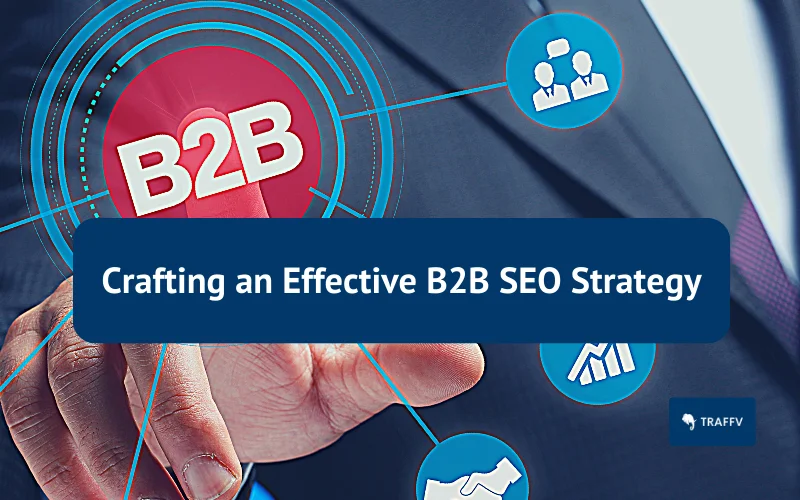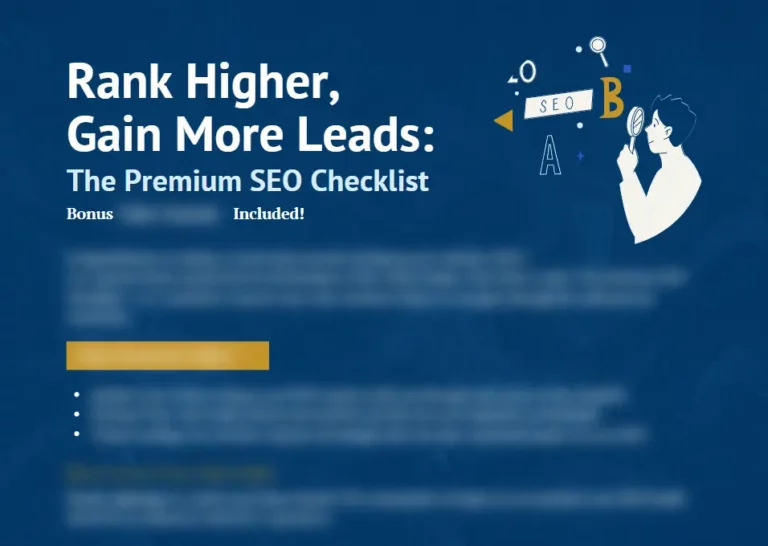In today’s competitive digital landscape, businesses need a strong online presence to succeed.
But how can you ensure your business stands out from the crowd?
The answer lies in crafting an effective B2B SEO strategy, which will not only improve your search engine rankings but also attract the right audience and drive conversions.
Are you ready to unlock the full potential of B2B SEO and propel your business to new heights?
Let’s dive in!
TL:DR
- B2B SEO is a strategic approach to optimizing online presence for businesses.
- Crafting effective B2B SEO requires an understanding of search engine algorithms, keyword research, on-page optimization and off-page strategies.
- Tracking KPIs and working with a professional agency can help optimize your strategy for lasting success.
Understanding B2B SEO
B2B SEO is all about optimizing your business’s online presence to attract other businesses and improve search engine rankings.
This involves focusing on critical factors such as keyword research, content creation, and link building.
But why should you care about B2B SEO?
Well, businesses that invest in a robust SEO strategy enjoy higher visibility in search engine results, increased organic traffic, and ultimately, more conversions and sales.
The Role of Search Engines in B2B SEO
Search engines play a crucial role in determining the visibility and credibility of your online presence.
They assess various factors, including the quality and relevance of your blog post and other content, to decide how your website should rank in search results.
As a result, optimizing your website to align with search engine algorithms is essential for a successful B2B SEO strategy.
One platform that shouldn’t be overlooked is YouTube, the second largest search engine after Google.
Video marketing can significantly contribute to your business’s online visibility and engagement.
Optimized videos on YouTube can appear in search results, providing an effective supplement to your blog, social media, and website content.
By focusing on creating valuable, shareable content and obtaining backlinks from reputable sites, you can improve your search engine rankings and attract more potential clients.
Key Components of B2B SEO
To create a successful B2B SEO strategy, you need to focus on three key components: on-page optimization, off-page optimization, and technical SEO.
On-page optimization involves enhancing the content and structure of your website, making it more attractive to both search engines and users.
Off-page SEO, on the other hand, encompasses activities like link building that take place on other websites, which can help improve your search engine rankings.
Finally, technical SEO refers to optimizing the technical aspects of your website to ensure compatibility with search engine technology, such as schema, AMP, and SSL.
By focusing on these three components, you can create a solid foundation for your B2B SEO strategy.
However, it’s essential to remember that SEO is an ongoing process, and you must continually monitor and adjust your efforts to stay ahead of the competition and maintain your search engine rankings.
Step 1: Define Your Target Audience and Buyer Persona
Defining your target audience and creating buyer personas is the first step in crafting an effective B2B SEO strategy.
This information will ensure you cater to the right customers and create content that resonates with them. This is crucial because it helps you understand the needs, preferences, and pain points of your potential clients, allowing you to tailor your content and marketing efforts accordingly.
By knowing who you’re trying to reach, you can optimize your website and content to appeal to your target audience, increasing the chances they’ll engage with your business and ultimately convert into customers.
Creating Buyer Personas
Developing buyer personas involves researching and understanding the needs, preferences, and pain points of your potential clients.
Consider factors such as industry, age, interests, demographic, and ranking within their company when constructing audience personas.
This information will help you create content and select keywords that are tailored to the individuals you’re trying to engage, increasing the chances they’ll find your website and engage with your business.
By understanding your target audience, you can create content that resonates with them and drives conversions.
Analyzing Competitors’ Audiences
Another valuable step in defining your target audience is analyzing your competitors’ audiences.
By examining your competitors’ engagement levels on their content and analyzing the quality of their content, you can gain insights into the target market and refine your own buyer personas.
Furthermore, reviewing your competitors’ social media and influencer collaborations can provide useful information about the strategies they’re using to engage their audiences.
This research can help you identify opportunities and gaps in your own marketing strategy, ultimately helping you create more effective content and campaigns.
Step 2: Conduct Effective Keyword Research for B2B SEO
Once you’ve defined your target audience and buyer personas, the next step is to conduct effective keyword research.
This is crucial for B2B SEO, as it helps you identify high-value keywords and phrases that your target audience is searching for.
By optimizing your website and content for these keywords, you can increase your visibility in search engine results and attract more potential clients.
Identifying High-Value Keywords
High-value keywords are those that are relevant to your target audience, have a high search volume, and low competition.
Identifying these keywords is essential for optimizing your website and content to rank higher in search engine results.
One effective way to uncover long-tail keywords, which are longer and more specific search terms, is to use Google’s autocomplete feature.
Additionally, understanding search intent, or the purpose behind a specific search query, can help you tailor your content to match the needs and preferences of your target audience.
Analyzing Competitors’ Keywords
Analyzing your competitors’ keywords can provide valuable insights into the search terms that are driving traffic to their websites.
This can help you identify potential keyword opportunities and gaps in your own strategy, allowing you to optimize your website and content for these keywords and improve your search engine rankings.
You can use keyword research tools to analyze your competitors’ websites and uncover the keywords they’re targeting.
Step 3: Optimizing On-Page Elements for B2B SEO
On-page optimization is a critical component of a successful B2B SEO strategy.
This involves improving the content and structure of your website to make it more appealing to both search engines and users.
By optimizing elements like meta titles, meta descriptions, and content structuring, you can create a website that is both user-friendly and search engine-friendly, increasing your chances of ranking higher in search engine results.
On-page optimization can help you create web pages that are both user-friendly and searchable.
Crafting Compelling Meta Titles and Descriptions
Meta titles and descriptions are essential elements of on-page optimization, as they provide a concise summary of your web page and inform both search engines and users about the topic of your content.
By crafting compelling and informative meta titles and descriptions that include relevant keywords, you can improve your search engine rankings and click-through rates.
Some tips for creating effective meta titles and descriptions include keeping them concise and informative, incorporating relevant keywords that accurately describe the content of the webpage, and avoiding keyword stuffing.
Structuring Content for Readability
Another key aspect of on-page optimization is structuring content for readability.
This involves using headings, subheadings, bullet points, and short paragraphs to make your content easy to scan and understand.
By optimizing your content for readability, you can improve user engagement and increase the chances your content will be shared and linked to by other websites.
Some tips for structuring content for readability include:
- Breaking up text into smaller paragraphs
- Using headings and subheadings to divide content into sections
- Incorporating bullet points or numbered lists to emphasize key points.
Step 4: Building a Strong Off-Page B2B SEO Strategy
Off-page B2B SEO focuses on building a strong online presence through link building, social media marketing, and other techniques that improve your business’s credibility and visibility.
By creating shareable content and obtaining backlinks from authoritative websites, you can enhance your search engine rankings and attract more potential clients.
In addition, engaging in social media activities can help you reach a wider audience and drive more traffic to your website.
Link Building Techniques
Some effective link building techniques include guest posting, broken link building, and creating shareable content.
Guest posting involves contributing content to other websites in exchange for a backlink to your own site, while broken link building involves contacting webmasters to suggest replacing broken links on their websites with a link to your content.
Creating shareable content that is valuable and informative can also help you earn high-quality backlinks from authoritative websites, improving your search engine rankings and driving more organic traffic to your site.
Step 5: Harnessing Technical SEO to Boost B2B Rankings
Technical SEO involves optimizing the technical aspects of your website, such as site speed and mobile-friendliness, to improve search engine rankings and user experience.
By ensuring that your website is compatible with the technology used by search engines, you can increase your chances of ranking higher in search engine results and attracting more potential clients through search engine optimization, using effective SEO strategies.
In addition, optimizing your website’s technical aspects can help improve user engagement and increase the likelihood that your content will be shared and linked to by other websites.
Improving Site Speed
Improving site speed is an essential aspect of technical SEO, as search engines prioritize websites that load quickly. Some tips for improving site speed include optimizing images, enabling caching, and reducing server response time.
By ensuring that your website loads quickly, you can provide a better user experience and increase the chances that users will engage with your content and convert into customers.
Ensuring Mobile-Friendliness
In today’s mobile-first world, ensuring that your website is mobile-friendly is crucial for both search engine rankings and user experience.
To optimize your website for mobile devices, focus on responsive design, easy navigation, and content that is easily readable on smaller screens.
By providing a seamless user experience on mobile devices, you can increase user engagement and improve your search engine rankings.
Step 6: Measuring and Analyzing B2B SEO Performance
It is crucial to measure and analyze your B2B SEO performance to identify areas of improvement and track the success of your overall strategy.
By monitoring your website’s performance and analyzing user behavior, you can make data-driven decisions to optimize your SEO efforts and achieve better results.
In addition, tracking your progress can help you stay ahead of the competition and maintain your search engine rankings.
Using Google Search Console and Google Analytics
Google Search Console and Google Analytics are essential tools for monitoring your website’s performance, tracking keyword rankings, and analyzing user behavior.
By using these tools, you can gain valuable insights into your website’s health, crawling and indexing issues, backlinks, and popular keywords, which can help you optimize your B2B SEO strategy.
In addition, Google Search Console can help you identify any errors or issues that may be affecting your search engine rankings, allowing you to address them promptly and maintain your website’s visibility.
Setting and Tracking B2B SEO KPIs
Setting and tracking B2B SEO KPIs, such as organic traffic, conversion rates, and keyword rankings, can help you measure the success of your SEO efforts and make data-driven decisions.
By monitoring these KPIs, you can identify areas where your strategy is working well and those that may need improvement.
In addition, tracking your KPIs can help you stay focused on your marketing objectives and ensure that your SEO efforts are aligned with your overall business goals.
Unmatched Business Growth with B2B SEO
Crafting an effective B2B SEO strategy is essential for businesses looking to stand out in today’s competitive digital landscape.
Partnering with an SEO agency can provide your business with expert guidance and support in crafting and implementing an effective B2B SEO strategy.
Don’t let your business fade into the background – harness the power of B2B SEO and propel your business to new heights!
Learn SEO for popular markets:
Frequently Asked Questions
What is B2B in SEO?
B2B SEO (business-to-business search engine optimization) is a digital marketing strategy designed to help B2B website pages rank higher in search engines.
It involves creating and optimizing pages on your website to target specific keywords that key decision-makers within companies search for when researching products or services.
Is SEO important for B2B business?
SEO is an essential tool for B2B businesses to increase visibility, attract organic traffic, and build brand awareness and loyalty.
It plays a crucial role in helping companies acquire customers, drive quality traffic, and accelerate growth.
What is the difference between B2B SEO and B2C SEO?
B2B SEO campaigns focus on increasing brand exposure and generating quality leads, while B2C SEO campaigns target immediate sales.
The decision process in the B2B market is longer than B2C due to higher costs or length of commitment.
What other SEO suggestions do you have for a B2B company?
Try optimizing your website for search engine results, utilize meta tags and backlinks, create compelling content, and use targeted keywords to improve visibility – these are some of the essential elements of a successful B2B SEO strategy.
Additionally, track results with analytics to ensure ongoing success.
What is the main goal of B2B SEO?
The main goal of B2B SEO is to optimize a business’s online presence to attract other businesses and boost search engine rankings.




